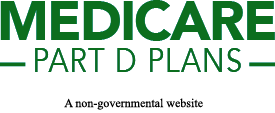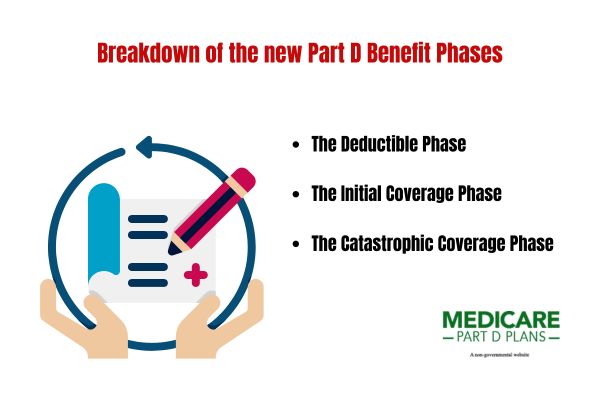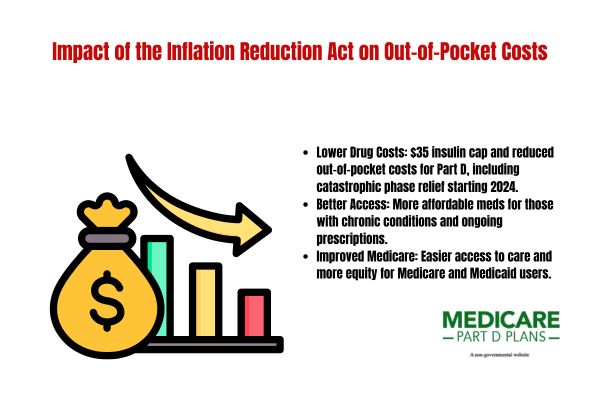Find a Medicare Part D prescription drug plan

Medicare Part D
Prescription Drug Coverage 2026
Out of Pocket Maximums in Medicare Part D -2026 Limits
If you’re wondering about the potential out-of-pocket maximums in Medicare Part D
Once you hit this limit, your costs for these drugs could potentially decrease, easing your financial burden for the rest of the year. This article will break down what this might mean for you and explain the different phases of Part D coverage.
Key Takeaways
- The out-of-pocket maximum for Medicare Part D might increase to $2,100, possibly providing essential financial protection against high medication costs.
- Beneficiaries will enter a Catastrophic Coverage Phase after reaching the out-of-pocket threshold, where they may incur lower costs for covered drugs for the rest of the year.
- Potential reforms from the Inflation Reduction Act could potentially lower overall out-of-pocket expenses and simplify access to affordable medications for Medicare beneficiaries.
Introduction
For the year
Overview of Medicare Part D Out-of-Pocket Maximums for 2026
Medicare Part D is a voluntary outpatient prescription drug benefit for people with Medicare. It could help Medicare beneficiaries manage the cost of their medications, possibly providing a layer of financial protection.
Understanding the potential out-of-pocket maximums and implications may more important than ever for those utilizing Part D prescription drug coverage.
The out-of-pocket cap could potentially protect beneficiaries from excessive medical costs by limiting the amount they may have to pay out-of-pocket for their prescription drugs. Once this limit has been reached, the costs for covered prescriptions may drop, possibly ensuring that healthcare remains affordable.
The primary purpose of the Medicare out-of-pocket maximum will likely be to shield beneficiaries from high drug costs. Medicare Part D could potentially ensure that those with significant medication needs could access their treatments without facing excessive costs.
This potential protection will likely highlight its role in supporting the health and financial well-being of Medicare beneficiaries.
2026 Annual Out-of-Pocket Threshold
The out-of-pocket threshold for Medicare Part D
This threshold could be vital for managing your healthcare expenses, as it will likely define the maximum amount you may pay out-of-pocket for your medications within the year.
Once you reach this maximum, you likely won’t have to worry about additional out-of-pocket spending on your medications, possibly providing peace of mind and financial relief for the remainder of the calendar year.
Breakdown of the New Part D Benefit Phases
The Part D benefit structure
- The Deductible Phase
- The Initial Coverage Phase
- The Catastrophic Coverage Phase
Each phase will likely play a critical role in determining how much you may pay out-of-pocket for your medications.
Understanding these phases could help you better navigate your prescription drug coverage and manage your costs effectively.
Deductible Phase
The annual deductible for the calendar year
This means that if your medication costs are high early in the year, you will likely need to pay out-of-pocket until you reach the $615 deductible.
Once you meet the plan deductible, you transition out of the Deductible Phase and move into the Initial Coverage Phase. Planning and budgeting for this phase could help ensure you cover these initial out-of-pocket expenses without financial strain.
Initial Coverage Phase
During the Initial Coverage Phase:
- Participants may pay up to 25% of the costs for their covered medications.
- This phase begins once you have met your deductible.
- It will likely continue until you reach the out-of-pocket threshold of around $2,100.
Enrollees may share up to 25% of medication prices, which might add up depending on your prescription costs.
This cost-sharing mechanism could potentially ensure you’re not bearing the full burden of drug costs, possibly making medications more affordable during this intermediate phase of coverage.
Catastrophic Coverage Phase
Once you exceed the out-of-pocket threshold, you enter the Catastrophic Coverage Phase. In this phase, beneficiaries might not face cost-sharing for covered drugs, as sponsors will likely cover a significant portion of expenses.
This phase could potentially provide financial relief, possibly ensuring that no matter how high your medication costs, you may not incur additional out-of-pocket expenses for the rest of the year. This protection could be particularly beneficial for those with chronic conditions requiring expensive medications.
Potential Impact of the Inflation Reduction Act on Out-of-Pocket Costs
The Inflation Reduction Act of 2022 will likely introduce several reforms that could potentially reduce certain out-of-pocket costs for Medicare beneficiaries. These reforms will likely be designed to make medications more affordable and accessible, possibly alleviating the financial burden on those who rely on prescription drugs.
One of the potential changes may be the reduction in overall out-of-pocket expenses for Medicare Part D beneficiaries, which might reduce the financial barriers to necessary medications.
Starting from January 1, 2024, beneficiaries in the catastrophic phase of Medicare might have a lower copay for covered drugs. Additionally, the Inflation Reduction Act might mandate a copay limit of about $35 for a month’s supply of a covered insulin product.
These potential changes could be particularly beneficial for individuals with chronic conditions who require ongoing medication.
The Act might not only lower certain costs but could also enhance the overall experience of traditional Medicare beneficiaries by making it easier to access affordable medications and Medicare and Medicaid services.
These reforms will likely be a crucial step towards a more equitable and sustainable health care system.
Medicare Prescription Payment Plan for Managing Costs
The Medicare Prescription Payment Plan will likely allow beneficiaries to spread out their out-of-pocket drug payments throughout the year. This voluntary option could potentially help manage high medication costs by breaking them down into more manageable monthly payments.
Beneficiaries may contact their plan to opt into the Medicare Prescription Payment Plan, and there is an automatic renewal process
The Medicare Prescription Payment Plan may help beneficiaries manage high medication costs and potentially avoid financial strain. This plan may be ideal for those who need to spread out their expenses and maintain a steady budget throughout the year.
See plans in your area instantly!
Advertisement
Potential Changes to Creditable Coverage Determination Methodology
The updated methodology might require group health plans to cover at least 72% of participants’ prescription drug costs. This could potentially enhance the quality of drug coverage provided by group health plans, possibly ensuring they offer a standard benefit to participants.
Tips for Managing Your Out-of-Pocket Spending
Enrolling in Medicare Part D during your eligibility window helps you avoid late enrollment penalties and manage certain out-of-pocket costs effectively for Part D enrollees. Comparing different Medicare Part D plans using the Plan Finder Tool on this website can help identify the most cost-effective options.
Implementing strategies such as using generic medications and medication synchronization might help beneficiaries stay under their out-of-pocket limits. Regularly tracking out-of-pocket spending may also keep you aware of your financial standing and helps avoid surprises.
Find a Plan and Enroll Online Yourself!
Advertisement
Summary
Understanding the potential changes to Medicare Part D out-of-pocket maximums
By staying informed and utilizing tools like this website, you can better navigate these potential changes and manage your out-of-pocket spending effectively. Take control of your healthcare costs and ensure you get the most out of your Medicare Part D coverage.
Frequently Asked Questions
What is the annual out-of-pocket (OOP) threshold for CY 2026 ?
The annual out-of-pocket threshold for CY
What is the annual deductible for CY 2026 under the Part D benefit?
The annual deductible for CY
How might the Medicare Prescription Payment Plan help manage costs?
The Medicare Prescription Payment Plan could potentially help manage costs by enabling beneficiaries to spread their out-of-pocket drug payments over the year, possibly simplifying the management of high medication expenses.
What changes might be made to the creditable coverage determination methodology for CY 2026 ?
The creditable coverage determination methodology for CY
How might the Inflation Reduction Act impact out-of-pocket costs for Medicare beneficiaries?
The Inflation Reduction Act could potentially reduce certain out-of-pocket costs for Medicare beneficiaries, such as offering capping copayments at around $35 for covered insulin and potentially eliminating copays for covered drugs during the catastrophic phase.
This might lead to significant savings for those enrolled in Medicare.
Begin Choosing your plan
Advertisement
ZRN Health & Financial Services, LLC, a Texas limited liability company.



